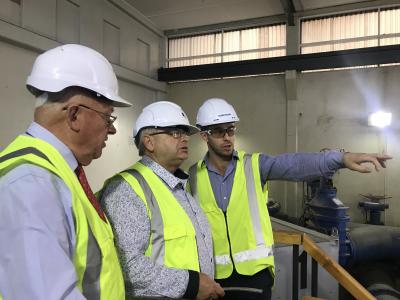Published 27/05/2019
“Like botox for the ground” – new technique builds resilience
The infrastructure that supports the water network could be negatively impacted after a large earthquake, resulting in significant disruption to the management of drinking water and wastewater. We’re taking this risk seriously, and are working to improve resilience across the network.
In early May, work began on ground improvement at the Seaview Wastewater Treatment Plant, where new resin injection technology is being used to strengthen the ground underneath key buildings, improving the resilience of the plant.
Hutt City Mayor, Ray Wallace and Hutt City Deputy Mayor and Wellington Water Committee Chairman, David Bassett recently visited the Seaview Wastewater Treatment Plant to check in on the progress of the ground improvement works currently underway.
“It’s incredibly important that key infrastructure such as the Seaview Wastewater Treatment Plant has the capability to operate as normal following a large quake, said Ray Wallace. “Wellington Water is working towards improving the resilience of these key plants, and it’s brilliant to see innovative technologies like this being used to keep normal operations going while the upgrade happens.”

Mike Baker of Mainmark (right) explaining the injection process and locations at the Seaview Plant to Hutt City Mayor Ray Wallace (centre) and Hutt City Deputy Mayor and Wellington Water Committee Chairman David Bassett (left).
Fran Wilde, chair of the Wellington Lifelines infrastructure group, shared her support for this work on earthquake resilience.
“This is a great example of how our region is now focussing on our essential lifeline infrastructure,” she said.
“Wellington’s earthquake risk is well known so all our lifeline providers are now stepping up with enhancement programmes. But householders also need to plan to be on their own for a period after a big event. So as we mark this occasion we should also have a think about how we would manage those essentials of life such as wastewater disposal if the big one struck our region tomorrow”.
Ground Engineering experts, Mainmark, have developed a non-invasive ground improvement and liquefaction mitigation technique, Terefirm™ Resin Injection, which can be applied under existing structures. Wellington Water’s Seaview project team has likened the technique to “botox for the ground”.
Going as deep at 7m into the ground (at the Seaview location), the engineered resin is injected through thin tubes, and distributes in a veining pattern through the soil. It then crystallises and expands to three to four times its original size. The resin works to create stable ground underneath key buildings in the plant, so it can move as one rather than being pushed and pulled in different directions during an earthquake.
Improving resilience isn’t just about being prepared for a large earthquake or disaster, it’s about repairing and recovering quickly. With the goal of having the plant continue to operate following a large earthquake, it’s important that we create strong foundations underneath existing structures, which will allow for reduced re-build efforts and a quicker return to full operation.
Originally researched by Mainmark in the Christchurch red zone, and underneath an operational retail space, Terefirm™ Resin Injection is a practical solution for the treatment plants and other important infrastructure in the water network, as they can continue to operate as normal while ground improvement works are being completed.
